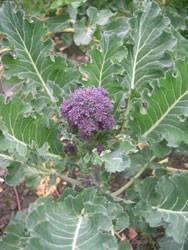Amaryllis and honey bees
Posted by Fiona Nevile in Bees, Plants and Bulbs | 8 comments
Amaryllis blossom in our bedroom
Hundreds of young bees were making test flights in the crisp sunshine. They do this to orientate themselves to the hive before making their first solo foraging flight. Having worked out the coordinates (they use the sun) they can venture for miles and always find their way back home.
I collected 3 eggs from the run and returned to the kitchen with the lightest step. Sunshine just does the trick. Every time.
I nipped upstairs to say goodbye to Danny before I left for work and stepped into the gloom of our bedroom. The curtain is gossamer thin. It just diffuses the light so it is often left undrawn for days. This morning I wanted to let the sun burst in and warm every crevice. I drew the curtain back.
Although I knew that we had a cache pot with two chunky amaryllis bulbs in bud, I was amazed.
One immense, magnificent head had finally opened. As we have these and the promise of three more buds, we are at the start of an extended flowering period that should last at least six weeks.
By then the young bees that I saw testing out their wings this morning will have died. Life expectancy at this time of year is short. They emerge after two weeks working in the hive – cleaning out cells and nursing. After an average of four foraging weeks their wings wear out and they die, generally in the fields.
The life expectancy of a worker honey bee in a winter colony is far longer as the weather affects foraging opportunities. Bees don’t like flying in windy weather. They can’t fly in wet weather and freezing weather keeps them indoors. Some bees can survive for four or five months.
If you hear a low melodious buzzing from a hive on a frosty day they are inside and clustered together keeping warm. The hum is the beating of bee wings to circulate the warm air that they generate.
Amaryllis and honey bees. We’re so lucky to see them blooming.
Leave a reply






I love wildlife gardening and dearly want to encourage more bees into our gardens. I am currently desining two pollination/bee gardens for friends and enjoy hearing other folks stories!
Hi Kate(uk)
Thanks so much for taking the trouble to write this and share all your tips! Now houses all over the world will be filled with giant amaryllis bulbs!
To get a cheapo amaryllis to bloom next spring- give it good compost,feed it well this year and give it sunshine in a sheltered spot all summer, keep it cool for 6 weeks or so in autumn, put it somewhere warm to start the growth and next spring, if the bulb has bulked up, it will bloom. The cheap ones can be just dull red, but sometimes you get interesting ones that are ‘left overs’ from breeding programmes- but it does pay to invest in good bulbs if you want them to have lots of blooms and last for years- the cheap ones do tend to need a lot of cosseting to keep them happy, and you do wonder, if the bloom quality isn’t too good,if they were worth the effort!
My first amaryllis started blooming about two weeks ago ( green with dark red stripes), I have three varieties blooming today ( lemon yellow with fine red stripes, the green one, pink with white stripe and green throat) and another ten or so on the sunny bedroom windowsill with buds growing fast- the other twenty are in the cooler conservatory and just starting to sprout…yes, I’m an addict. My mother has three bulbs that she has had since 1999- they are the most spoilt amaryllis in the universe. The bulbs are now HUGE and this year she had, for the first time, a flower head with 6 blooms on it- this being one of three flower stems from this one bulb.Fantastic!
Celia- give your bulb some liquid feed, keep it somewhere sunny- the cheap bulbs have sometimes not been given the cold spell they need to bring the blooms on- you may well get a surprise set of buds appearing in May/June, if my bulbs don’t bloom in spring they often do so later in the year.
Hi Magic Cochin
A client’s Mother took up beekeeping during the war (WW2) to get the sugar too. Rationing must have been hell. I love our bees, they increase the yield in our garden and give us honey too.
These amaryllis were a Christmas present from my mum. I am going to follow Kate(uk)’s advice and try and keep them going for next year. I’ve gone down the cheap amaryllis route too. Very disappointing.
Hi Sharon J
Yes the life span is very short. It’s sad to think that their wings ware out.
Yes, I know a few people who keep bees on allotments. They help pollinate the crops so are beneficial. I thing that you’d have to ask permission from the committee first.
What a shame that you missed out on indoor bulbs this year. Hope that you are better now.
Hi Scott at Real Epicurean
Thanks. Great that you are enjoying the site.
Looking forward to seeing what recipe you come up with on your blog!
Hi Pamela
Yes the rate of growth is amazing. These are on a south west facing windowsill and love the sun and warmth.
Good story about the worktop amaryllis!
I usually only buy amaryllis when they are reduced for a quick sale because the box has got a bit tatty. I am always amazed at the rate of growth and how one stem can support the weight of such huge flowers. I once had one that was happily growing at back of the kitchen worktop when I went to bed, only to find it had developed a severe crick in the neck when I came down for breakfast the next morning as it had hit the underneath of the wall cupboards! Fortunately it recovered and went on to bloom magnificently.
I love your writing style.
I’m in a honey mood recently and reading your post about bees has inspired me to head into the kitchen to see what I can come up with.
Wow! I never knew bees had such short lives. Now I shall appreciate them even more.
Your lifestyle sounds absolutely wonderful and I’m very envious. Fresh eggs, honey, fruit and veg… do you happen to know whether it’s possible to keep a bee hive on an allotment?
I’ve been ill for a while now so didn’t plant any bulbs for indoor blooming. I miss the scent of Hyacinths and the amazing flowers of Amarylis.
How fascinating to hear about your bees. Apparently my Gran kept bees in the war – entitling her to extra sugar rations in the winter (I think she let her bees eat the honey and she made plum jam!)
I’ve recently designed a honey label for our County Councilor who lives near Newmarket, she’s a very keen beekeeper and has invited me to meet her bees later in the year.
My cheap Amarylis from Saffron Walden market has beautiful leaves but no flowers, the posh one from Waitrose which I gave to my Mum for Christmas has four triumphant blloms and she’s thrilled with it!
“You pays your money and takes your choice”.
Celia